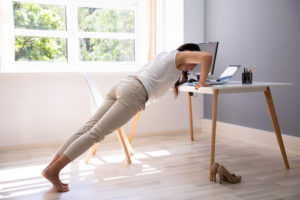
Here’s how to exercise at work for good health. Boost blood flow and productivity during your day.
The number of Americans working at desk jobs is on the rise. And with the COVID pandemic, many people are now working from home and adapting to new routines. Research in the past decade has revealed that sitting at a desk all day may actually be detrimental to our health. So it’s only one more reason that a little exercise at work can help us all.
Some scientists consider sitting to be the new smoking! Studies have found that a sedentary lifestyle is correlated with an increased risk of neck and lower back pain, metabolic syndrome, and obesity. (1) Making time for movement can boost your health – physically and mentally. Exercising at work can also decrease your stress while making you more energized, focused, efficient and productive. Increased productivity can lead to financial benefits, too. (2,3) Even a short and simple workout can make a big difference. (3)
This post contains an affiliate link. As an Amazon Associate, we earn from qualifying purchases. The link is noted with an asterisk (*) or Amazon image.
So, how exactly does exercise at work help us?
Exercise can reduce our levels of stress hormones, and sweating releases endorphins that can help keep us calm. Getting our bodies moving also improves blood flow throughout the body, including to the brain. This increased flow of fresh oxygen to the brain can help you stay focused and think at peak potential. Those who exercise also tend to have improved quality of sleep. To help avoid what some are calling the new sitting disease, here are some short and simple ways to get moving during the workday!
- Planks
- Walking push-ups
- Office chair tricep dips
- Office chair squats
- Weighted squats with office “weights”
- Russian deadlifts with office “weights”
- Invest in a standing desk
Keep reading for some instructions and insight about each of these!
Yoga mat exercises
Packing a yoga mat for work, or keeping it next to your at-home desk may feel odd at first, but before you know it, you’ll feel confident, stronger, and more productive. You may even inspire your colleagues to start doing some yoga mat exercises, too! If you’re on Zoom calls throughout the day, recruit a fe of your coworkers to do a 5-10 minutes mid-day yoga session right before lunch. Here are some mat exercises to fit into your break time:
Power up with planks
When it comes to office core workouts, planks are the winner. They are an isometric exercise that recruits a range of muscles throughout the body and requires minimal space. When done correctly and with slow progression, planks are considered to be safer than sit-ups, as they do not put strain or compression on the spine. If you want to switch it up, you can add in some crunches, which are also considered safer than sit-ups. (4) To start, try three sets of planks and hold for 30 seconds each. Between each set, add ten crunches.

Walking push-up
If you have a private office or workout room at work, or a good open spot at home, a walking push-up is a great option. It combines core and cardio in one single exercise.
To do a walking push-up (or commonly referred to as an inch-worm pushup), start in a normal push-up position, then slowly walk your feet towards your hands. You’ll work out your arms and chest muscles, plus get a nice cardio boost! Not sure about form? Take a look at a couple of YouTube videos, and always listen to your body!
Office chair exercises
For chair exercises, make sure you find a stable chair without wheels. Gradually increase the number of sets and reps over time. Here are some chair exercises to start with.
Tricep dips
- Scoot to the front of the chair and place both palms on the chair so that your fingers are facing forward.
- Bend your knees so they are at a 90-degree angle or straighten your legs for a more challenging exercise.
- Bend your elbows back and lower yourself straight down several inches. For safety, keep your back as close to the chair as possible.
- Then, straighten your arms to the position you started with.
- Repeat 10-20 times.
Chair squats
- Stand in front of the chair with the chair behind you.
- Place your feet shoulder-width apart.
- Push your hips backward, bend your knees and lower yourself down slowly so you are nearly sitting in the chair.
- Then stand up slowly, making sure your back is straight for the entire process.
- Repeat.
You can also sit in an imaginary chair against the wall and hold for 30 seconds, working your way to “sit” longer. Always make sure your knees don’t extend past your toes!
Leg exercises
Muscle mass is lost when it’s not used, but there are simple ways to prevent that! If you are primarily sitting throughout the workweek, it’s important to find other times to use those leg muscles. With leg exercises, keep in mind that correct posture is more important than achieving a certain number of reps. Try these leg muscle exercises to help your legs stay strong and ready for your next adventure.
Squats (engage those quads and glutes!)
- Stand with your feet hip-width apart and grab a couple of books or another form of added weight. You can also choose to do this exercise without any added weight (body-weight squats are effective too!).
- If you’re using weight, hold it near your chest, then, steadily lower down as if you are going to sit on a chair but stop before you hit the imaginary seat.
- Make sure your knees are still pointing forward, not starting to point inward, and don’t let them pass your toes for proper form.
- Then push yourself back to standing. This counts as one rep.
- Start with three sets of eight reps.
If this is too challenging, start by holding on to something for balance and stability, then work your way towards unassisted single-leg squats.
Weighted RDL (Russian Deadlifts)
Find two books or another item on your desk or in your office that are around 5 pounds. Then follow the steps below:
- Hold one object in each hand.
- Stand with your feet shoulder distance apart.
- Slowly bend at your hips while keeping your legs slightly bent, and your spine straight. Sliding your arms so that they stay inches from the front of your legs.
- Once you get to about shin length, slowly lift your torso up, still sliding your arms close to the front of your legs, keeping your back straight and your knees slightly bent.
- Repeat this 10-15 times.
This is a great exercise to do randomly throughout your work day for a full-body wake-up! The exercise primarily targets your hamstrings, but you’ll also engage your arm muscles, back, and core.
Sitting-standing desk
Several years back I purchased a sitting standing desk and it’s really helped with back pain. Now they have attachments you can put right on your desk to elevate your computer and keyboard for a fraction of the cost. Choose one with ample space for your notes or references. We like Stand Steady’s Dual Level Desk*.
Now that you have a few ideas, schedule them into your work breaks! Set a time on your phone or make a pack with a coworker. Make sure your intentions to move more don’t disappear, and instead, become part of your daily routine!
References
- Sedentary behavior and health outcomes among older adults: a systematic review. https://www-ncbi-nlm-nih-gov.ezproxy.cul.columbia.edu/pubmed/24712381
- https://journals.humankinetics.com/view/journals/apaq/9/2/article-p148.xml
- Physical Activity and Exercise Interventions in the Workplace Impacting Work Outcomes: A Stakeholder-Centered Best Evidence Synthesis of Systematic Reviews. https://www-ncbi-nlm-nih-gov.ezproxy.cul.columbia.edu/pubmed/27112715
- https://www.issaonline.com/blog/index.cfm/2016/are-sit-ups-bad-for-you-the-us-military-seems-to-think-so



